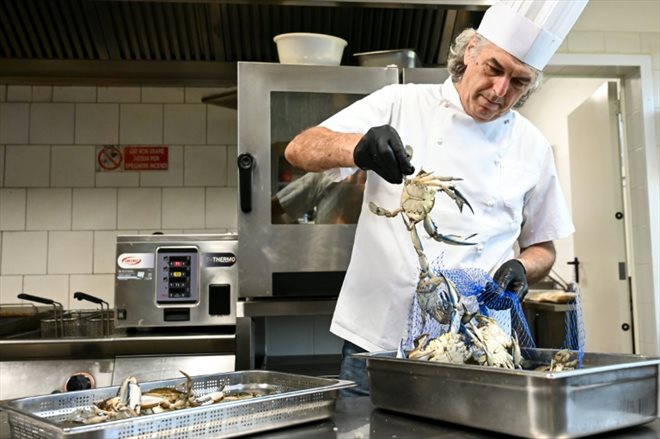A fisherman holds a blue crab in the Scardovari lagoon, south of Venice, on August 11, 2023 (AFP/Piero CRUCIATTI)
In the waters of the Scardovari lagoon, fishermen harvest clams for the preparation of a very popular dish in Italy, the famous “spaghetti alle vongole”, an activity endangered by the blue crab.
This invasive species, native to the Atlantic coast of North America, has been present for years in the Mediterranean, but in recent months its accelerated multiplication has become a serious problem on the Adriatic coast near Venice.
“Blue crabs devour everything. This lagoon is becoming a desert,” laments Gianluca Travaglia, a 52-year-old clam and mussel producer.

A fisherman throws blue crabs into the Scardovari lagoon, south of Venice, on August 11, 2023 (AFP/Piero CRUCIATTI)
He took over the business of his father and grandfather on the Scardovari lagoon, one of the branches of the Po estuary, the largest river in Italy that flows into the Adriatic Sea.
“Every day that passes we catch more and more, I don’t know what to do,” the fisherman confesses helplessly to AFP, guiding his boat on the lagoon.
His colleagues are faced with the same situation: “they can’t even use their nets anymore because the crabs come on them and break the threads!”.
– Subsidies –
The government released 2.9 million euros last week to deal with what Agriculture Minister Francesco Lollobrigida described as a “critical situation”.

Fishermen collect clams in the Scardovari lagoon, south of Venice, on August 11, 2023 (AFP/Piero CRUCIATTI)
The money is intended to provide “economic incentives” to those who catch and dispose of blue crabs, which are multiplying in “dangerous” ways, he explained, noting that Italian waters have no fond natural predators. of this species.
Coldiretti, the main organization representing the agricultural sector, denounced for its part an “invasion” caused by climate change. This species “exterminates clams, mussels, eggs, other fish and molluscs, endangering the survival of 3,000 companies in the Po delta”, she worried.
From the coasts of the United States, blue crabs (whose scientific name is “callinectes sapidus”) have spread throughout the world, presumably through the ballast water of ships.
For several years, fishermen working from Albania to Spain via France have been able to observe the presence of this alien species, which affects the natural balance of the native fauna.
Excellent swimmers, they can weigh up to a kilo and eat almost anything using their slender blue claws, which are particularly well suited for opening the shells of clams.
– Spaghetti with blue crab –
In Eraclea, another coastal town east of Venice, a restaurateur decided to explore the culinary uses of this tasty new ingredient.

Italian chef Luca Faraon prepares to cook crabs near Venice, Italy, August 11, 2023 (AFP/Piero CRUCIATTI)
“You can prepare many dishes with blue crab”, rejoices Luca Faraon, while his customers enjoy spaghetti with blue crab cooked with garlic, cherry tomatoes and parsley.
“We are still trying to figure out how to use it in a dessert,” jokes the 58-year-old restaurateur.
In the United States, in the Chesapeake Bay, near Washington, the blue crab is very popular.
During a meeting with representatives of the sector last week, the Minister of Agriculture, even if he recognizes the seriousness of the situation, preferred to focus on possible outlets in the United States and China. “Blue crabs are a great resource,” he said, highlighting their high vitamin B12 content.
This optimism is not at all shared by Emanuele Rossetti, a biologist with the fishing consortium Polesine, one of the most important shellfish farming associations in Europe.
Clams, which cannot survive in an environment invaded by blue crabs, are the core business of its members, he explains, while the number of blue crabs, present in the lagoon for fifteen years, has increased “exponentially” in recent months.
At the rate they are “devouring clams”, he says he is “certain that the fishermen of the consortium will find themselves without goods to sell after December”.
© 2023 AFP
Did you like this article ? Share it with your friends with the buttons below.




